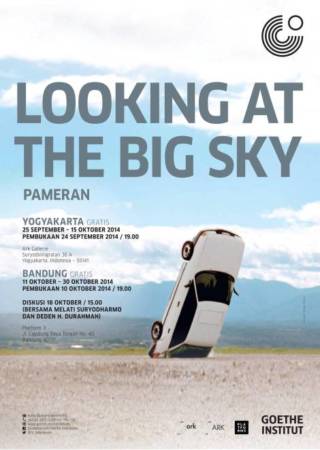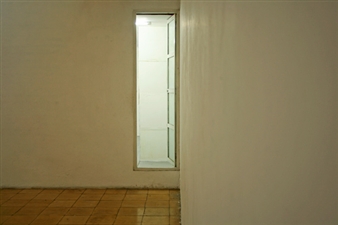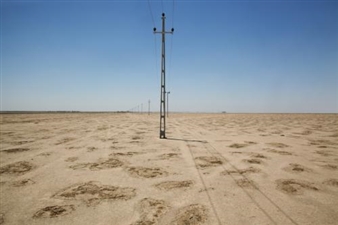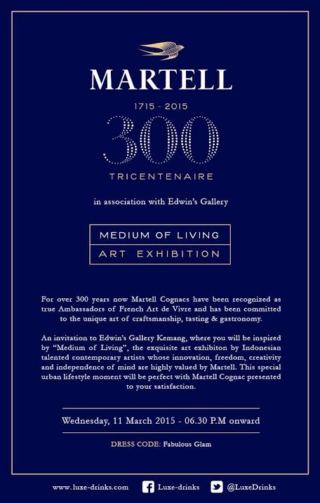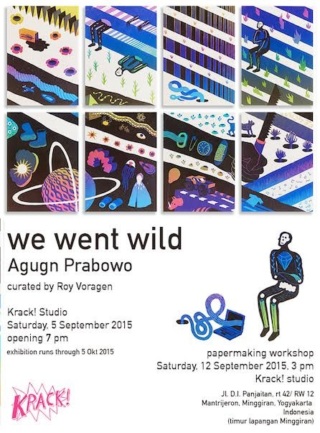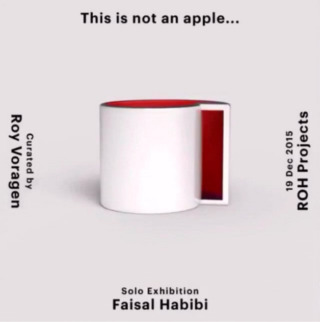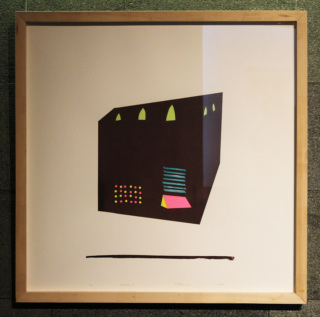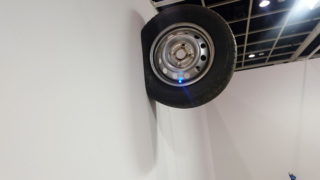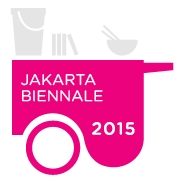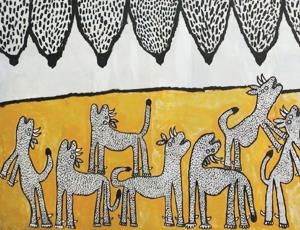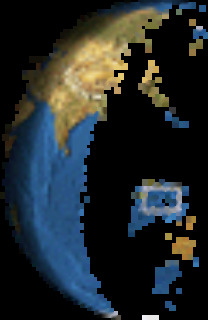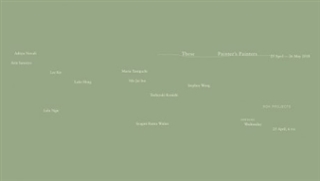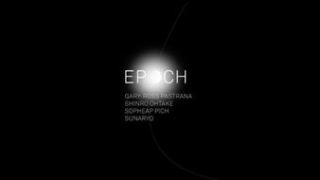Unguarded Guards
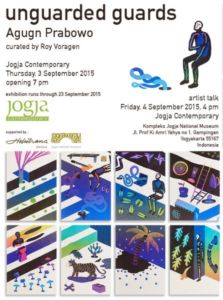
Jogja National Museum, Yogyakarta, Yogyakarta, 09/03/2015 - 09/23/2015
Jl. Prof. Ki Amri Yahya No. 1, Gampingan, Wirobrajan, Daerah Istimewa Yogyakarta
Visual artist Agung - better-known under the moniker Agugn, which is more of a graphic gesture - Prabowo (Bandung, Indonesia, 1985; agugn.tmblr.com) graduated in 2010 from the Institute of Technology Bandung's art school, where he studied in the printmaking studio. To conclude his BFA, he used the woodcut technique for his final work. Today, this prolific visual artist is well known for his art utilizing the printmaking technique linocut.
After graduation, Agugn joined a printing company, but his employment didn't last too long as he felt unhappy to be creatively caged. After leaving this company, and a monthly paycheck that comes with job security, he and his wife, the artist Sekarputri Sidhiwati, founded their very own printing company Let's go Press (letsgopress.tumblr.com) in 2012, which specializes in the letterpress technique; but, most of all, he returned to where his heart belonged all along: visual art and risky explorations and experimentations in techniques, materials, tools, aesthetics and artistic ideas.
Agugn has shown his works in group exhibitions at home across Indonesia, and abroad in Singapore, Japan and Spain. Moreover, in 2012, he was announced first winner by the jury of the Indonesian Printmaking Triennale, which resulted in the touring solo exhibition Natural Mystic in 2013 (Bentara Budaya, Jakarta, Yogyakarta, Bali and Solo). In 2014, he was one of three awardees at the Jogja Mini Print Biennale and he received the Young Artist Award at ArtJog, both in Yogyakarta, and both lead to exhibition participations in 2015. At this year's ArtJog, he showed We Are All Made of Stars, symbolizing the different elements it used five different techniques: carborondum, woodcut, photolithography, linocut, and fingerprints by members of the audience, and all five on handmade paper.
The artist is very productive. And this prolific output is both for technical as well as for conceptual reasons. To be able to print, the artist needs to know what he wants to achieve. And to know what is achievable, the artist needs to print, a lot. Therefore, it is a reflexive going back-and-forth trial-and-error between printing - and its techniques, materials and tools - and artistic ideas. Printmaking, for Agugn, is, thus, the art of playfully making use of limitations and, in the process, pushing his very own artistic boundaries.
When his wife was pregnant with their son Lino Apta, Agugn moved from woodcut to the linocut technique as the former technique produces hazardous waste of scraps of wood fiber (his studio is at home).
Lino Apta is a great gift, a life-altering gift.
His father-in-law, the artist Ipong Purnama Sidhi, gave him carving tools as a present, which are, obviously, essential to an artist who wants to use the linocut technique. And of these tools, he mostly uses two: the U- and V-shaped ones to achieve sharp, tiny lines.
Good lino plates are difficult to come by in Indonesia. After ample research, Agugn decided on an alternative: he started using a material typically used to make soles for shoes. He draws directly on these plates, and, subsequently, he cuts into these plates. He doesn't use different plates to print different colors, instead he carves again on the same plate to print different colors (using reductive methods).
The artist prints the plates using reduction techniques with L-shaped registration. He has two presses in his studio, a small, vertical press for maximum 40x40cm and a bigger, flatbed press for maximum 45x65cm. Agugn himself built both these presses. The two custom-tailored presses have due to their limited size an impact on what he can achieve in terms of dimensions, therefore, if he decides that an artwork requires a larger size he has to work modular and either show more sheets of paper in one frame (Family Matters in his solo exhibition Natural Mystic is an example) or show the work in a grid with each print separately framed (sleepless, for example, in this exhibition). This results in a mosaic, which has the benefit that different sheets can be treated with different colors and also can be given different images. He also makes this technical limitation work for him conceptually. The modular approach shows how we stand amidst our life-worlds (yes, plural, as we all move in-and-out different contexts - or grids, as the artists puts it - continuously): together yet separate, nearby yet far…
The paper the artist uses for his prints are hand-made, one of its ingredients is recycled paper from newspapers as well as from test prints; the paper is textured and thick yet porous. And he uses ink usually used for offset printing. The hand-made paper has the ability to absorb the oil-based ink, which makes the colors look vivid and vibrant. The paper isn't just hand-made, the artist also, through research, designed its formula to make it perfect for printmaking.
Printmaking requires meticulous precision and Agugn is a perfectionist, yet, he sees mistakes and improvisation as part of his practice. Sometimes, a good mistake can lead to something rather unexpected worthwhile exploring further. And for him printmaking is a painstaking process and at the very same time he seeks and needs the repetition that comes with his medium of choice. He doesn't want to work in any other medium - for example, painting or drawing - because repetition is so important, which he likens to a spiritual, mantra-like process.
There is a DIY-quality to Agugn's artistic practice: handmade paper, custom-made presses, and plates and ink sourced from unlikely places. Furthermore, the linocut technique was self-taught.
Agugn's work deals with intimate, private spaces and how the wider world has a bearing on these spaces. The relationships of the intimate and the private with a larger social ecosphere are one of complexity, perforated by everyday contradictions because of the proximity of different dogmas and their norms, and to translate all this to a two-dimensional plane requires the artist to make good use of juxtaposition, often in conjunction with the mosaic approach. Therefore, in a great many of the works a lone figure is surrounded by the miscellaneous signifying something and sometimes nothing.
To understand the world Augn has created thus far, one for sure has to look at two bodies of his work: the aforementioned Natural Mystic and also Abducted by Himself, exhibited at Selasar Sunaryo Art Space's fourth installment of Bandung New Emergence (in the Soliquy section) in 2012, for which he created an artist book and a large collection of small, framed works. The latter deals with his stint at the printing company and how he felt trapped in his body working there.
In these previous artworks, the artist explored the ambiguous notion of fear; the ambiguity of fear revolves around the issue that fear, while generally unwanted, can have unexpected yet ultimately worthy consequences - for example, art.
Tossing and turning… the sleepless nights, wide-awake, weary, dreading the morning light. Walking on pins and needles in anxious anticipation of what might come along the way. Worries about money. Demands made by the extended family and religion. Contemporary art seemingly demanding this or that. Throw ego into the mix, and you have a variety of conflicting claims causing stressful restlessness. Or, in other words, how to live - and carve out a living - within the complex conundrums of liquid modernity?
The artist became a father two years ago and fatherhood shed new light on his life and life's priorities. He wants to protect the infant - named Lino Apta - and keep him safe from harm, however, he knows, in anxious anticipation, that protection has its limits - a paradox…
In his solo exhibition unguarded guards at Jogja Contemporary, he shows a completely new body of work using linocut, photolithography and a combination of the two techniques, all printed on hand-made paper. The new body of work expands on the concept of fear and centers on the idea of how paradoxical protection actually is.
The parent ultimately aims to protect the child from - potential - harm. However, a sensible parent also recognizes the paradox: there are limits to how a child can be shielded from harm.
Recognizing this paradox enables one to enjoy the laughter, and, also, the charm of the unexpected that's all part and parcel of unconditional love.
In the exhibition unguarded guards, the work sleepless is the centerpiece. It is an epic work. Agugn's ambition to achieve this work literally caused him to burn the midnight oil night after night, working till dawn to print the 44 sheets of paper three times for each color with the linocut technique. And the 44 sheets, each 24.5x24.5cm, are separately framed (each frame is 27x37cm). The sheer size of this work, not to mention the explosion of colors…
The mixing of miscellanea, the juxtaposing of real objects with the fantastical… resulting in a magical realism. Worlds twirling and swirling within worlds - and not merely topsy-turvy, as hierarchy and scale have been abandoned. This labyrinthine of intersections and jams offers a near infinite way of engaging with sleepless.
The work sleepless sums up what Agugn aims to achieve: risky explorations and experimentations to achieve by arranging and re-arranging and composing the images he has in his mind so we can experience it is a whole as well as each part separately and independently.
Other new works included in the show are Chill #1-3 (photolithography, which is a technique that can show a brushstroke so it can capture the artist's hand while still retaining the sense of repetition, three colors on each sheet of paper of 28x20cm each with 15 sheets in one frame); Kundika #2 (linocut, cobalt blue, 96x120cm, because he doesn't have a big press, he printed manually using a spoon and his hand); and Surface (a combination of photolithography (photos he found through Google search) and linocut (to block colors), 20 frames of each 36x48cm).
- Roy Voragen (Bandung-based writer & curator; issuu.com/royvoragen)
For More Information